Sony Carl Zeiss Vario Sonnar 16-35 mm f/2.8 T* SSM
4. Image resolution
Let’s deal with the frame centre results from the A100 reflex camera first. The appropriate graph is presented below.
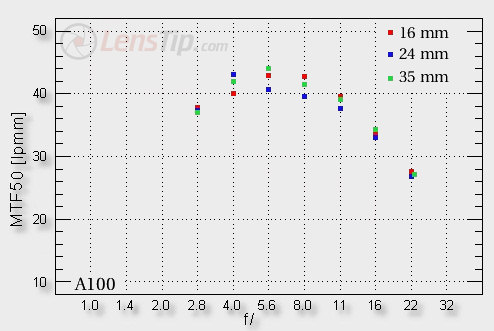
Please Support UsIf you enjoy our reviews and articles, and you want us to continue our work please, support our website by donating through PayPal. The funds are going to be used for paying our editorial team, renting servers, and equipping our testing studio; only that way we will be able to continue providing you interesting content for free. |
- - - - - - - - - - - - - - - - - - - - - - - - - - - - - - - - - - - - - - - - - - - - - - - -
At once, some important things become conspicuous. Firstly, the lens is fully useful from the maximum relative aperture. In fact, it is even more than useful, as the MTF50 values by f/2.8 reach about 37 lpmm – it means that pictures are so sharp that they can satisfy even demanding users. Second important thing is a very even performance. Even taking into account measurement errors, the lens fares similarly at all focal lengths. It is the real asset when you consider such difficult focus-aperture combinations as are available here!
Now it’s time for our reservations. If we talked about a device 2 or 3 times cheaper I wouldn’t complain at all but when we must spend almos 2000 USD on a lens and it’s a legendary Zeiss (noblesse oblige) we should expect the highest performance possible. The first problem occurs when we compare the chart above with the analogic Sony/Zeiss 24-70 mm resolution chart. Here the maximum MTF values reach the level of 43-44 lpmm, there they exceeded the 40 lpmm level even at maximum aperture and by f/4.0 and f/5.6 they reached 46-47 lpmm. Of course we are fully aware that manufacturing a fast, ultra-wideangle zoom lens is more difficult than the production of a standard 24-70 mm lens but still we feel a bit unsatisfied. After all, Zeiss managed to manufacture the best 24-70 mm zoom in its class available on the market, small wonder we expected the same in the case of a 16-35 mm lens.
The second small reservation we have when it comes to the middle aperture range performance. At maximum aperture the results are good, on closing down by one stop – even very good, so, according to the plan, by f/5.6 the performance should be outstanding. Well, it isn’t. For some unknown reasons the MTF values decrease sharply and they stand out in the negative sense from results obtained at other focal lengths. It’s not the matter of measurement errors because we observed a similar performance on different testing charts with different sizes and for both bodies – the A100 and the A900. The problem is not very serious because the results of about 40 lpmm are still very good but it is a bit disappointing that the lens fails exactly when we wanted to see it breaking resolution records.
As we didn’t let sleeping dogs lie and already mentioned something about the frame centre performance for the A900, it’s time to show the whole chart.
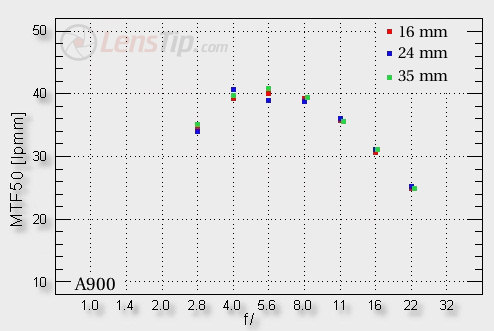
It isn’t surprising that it is very similar to the A100 chart. Both reflex cameras are characterized by the almost the same linear pixel density and it is the source of the same MTF values results when using the same lens. What’s interesting, the dispersion for the A900 is even smaller than for the A100, although here we enter discussion about differences within the margin of error so we won’t continue it – let’s move to the description of the frame edge performance.
We start with the APS-C/DX sensor edge. The lens’s results from the A100 are presented in the chart below.
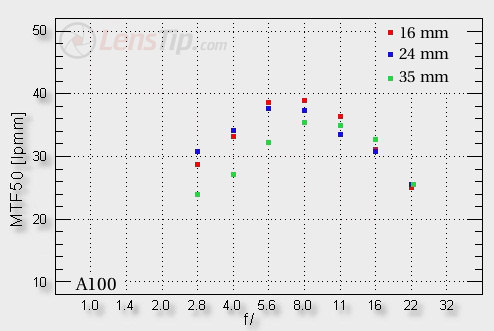
In fact, we can’t have the smallest reservations for the range of 16-24 mm. Even at maximum aperture the MTF values reach the decency limit, determined by us as 30 lpmm. On stopping down the MTF50 values increase reaching even 38 lpmm and it means very good quality, sharp photos. Significantly weaker performance is noticed at 35 mm. Here, by f/2.8 and by f/4.0 the MTF values reach just 30 lpmm and only stopping down by 2 EV can make the situation better, giving us good quality pictures.
The situation is repeated at the full frame matrix edge, which can be seen on the graph below.
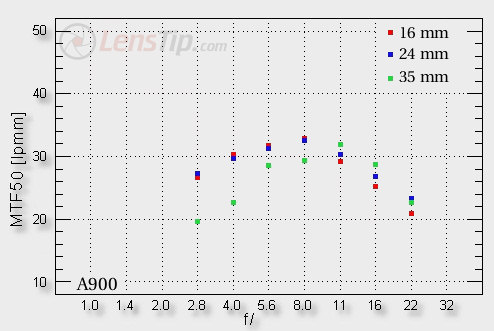
The graph shows that manufacturing an ultra-wide, fast lens, which doesn’t weigh several kilos and can be stored in a normal photo bag is very difficult indeed. Even such company as Zeiss had to work out a significant compromise. The full frame edge picture quality is a bit weak, especially at wide aperture at all focal lengths. It is true that the difference between the obtained results and the 30 lpmm decency border is small but still it exists. Fortunately, on closing the aperture by 1 EV we get both the wide angle comfort and sharp edges. The weakest performance we notice for the maximum focal length - here we have to stop down by more than two stops - but, as most of us can use the 35 mm focal length in our standard zoom lenses, Zeiss can be easily forgiven this small weakness.
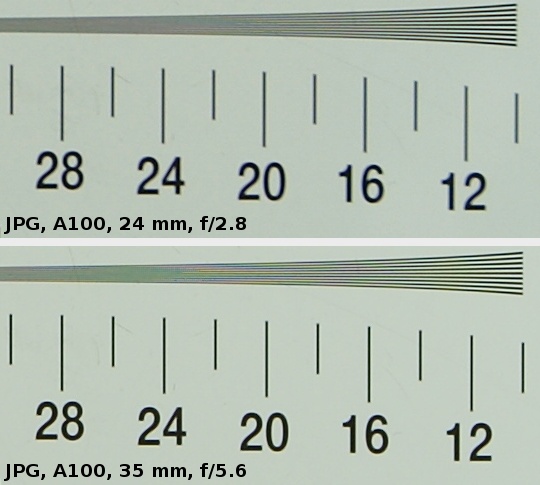 |






